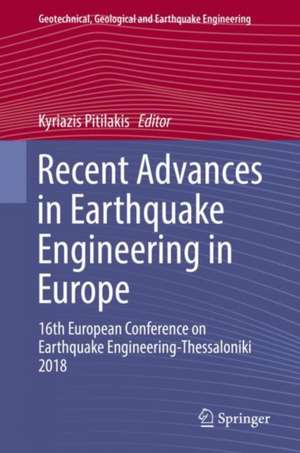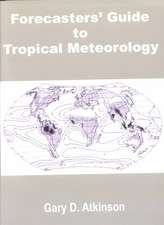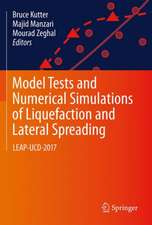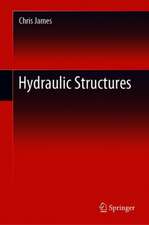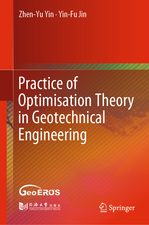Recent Advances in Earthquake Engineering in Europe: 16th European Conference on Earthquake Engineering-Thessaloniki 2018: Geotechnical, Geological and Earthquake Engineering, cartea 46
Editat de Kyriazis Pitilakisen Limba Engleză Hardback – 17 mai 2018
This book is a collection of invited lectures including the 5th Nicholas Ambraseys distinguished lecture, four keynote lectures and twenty-two thematic lectures presented at the 16th European Conference on Earthquake Engineering, held in Thessaloniki, Greece, in June 2018. The lectures are put into chapters written by the most prominent internationally recognized academics, scientists, engineers and researchers in Europe. They address a comprehensive collection of state-of-the-art and cutting-edge topics in earthquake engineering, engineering seismology and seismic risk assessment and management.
The book is of interest to civil engineers, engineering seismologists, seismic risk managers, policymakers and consulting companies covering a wide spectrum of fields from geotechnical and structural earthquake engineering, to engineering seismology and seismic risk assessment and management. Scientists, professional engineers, researchers, civil protection policymakersand students interested in the seismic design of civil engineering structures and infrastructures, hazard and risk assessment, seismic mitigation policies and strategies, will find in this book not only the most recent advances in the state-of-the-art, but also new ideas on future earthquake engineering and resilient design of structures.
The book is of interest to civil engineers, engineering seismologists, seismic risk managers, policymakers and consulting companies covering a wide spectrum of fields from geotechnical and structural earthquake engineering, to engineering seismology and seismic risk assessment and management. Scientists, professional engineers, researchers, civil protection policymakersand students interested in the seismic design of civil engineering structures and infrastructures, hazard and risk assessment, seismic mitigation policies and strategies, will find in this book not only the most recent advances in the state-of-the-art, but also new ideas on future earthquake engineering and resilient design of structures.
Chapter 1 of this book is available open access under a CC BY 4.0 license.
| Toate formatele și edițiile | Preț | Express |
|---|---|---|
| Paperback (1) | 917.23 lei 38-45 zile | |
| Springer International Publishing – 15 feb 2019 | 917.23 lei 38-45 zile | |
| Hardback (1) | 927.50 lei 38-45 zile | |
| Springer International Publishing – 17 mai 2018 | 927.50 lei 38-45 zile |
Din seria Geotechnical, Geological and Earthquake Engineering
- 15%
 Preț: 665.73 lei
Preț: 665.73 lei - 18%
 Preț: 1405.90 lei
Preț: 1405.90 lei - 15%
 Preț: 717.59 lei
Preț: 717.59 lei - 18%
 Preț: 959.19 lei
Preț: 959.19 lei - 15%
 Preț: 656.43 lei
Preț: 656.43 lei - 18%
 Preț: 1944.11 lei
Preț: 1944.11 lei -
 Preț: 392.60 lei
Preț: 392.60 lei - 18%
 Preț: 954.62 lei
Preț: 954.62 lei - 18%
 Preț: 954.45 lei
Preț: 954.45 lei - 15%
 Preț: 638.24 lei
Preț: 638.24 lei - 18%
 Preț: 954.45 lei
Preț: 954.45 lei - 15%
 Preț: 640.24 lei
Preț: 640.24 lei - 20%
 Preț: 572.65 lei
Preț: 572.65 lei - 24%
 Preț: 805.38 lei
Preț: 805.38 lei - 20%
 Preț: 602.77 lei
Preț: 602.77 lei - 15%
 Preț: 639.08 lei
Preț: 639.08 lei - 18%
 Preț: 1242.83 lei
Preț: 1242.83 lei - 15%
 Preț: 639.73 lei
Preț: 639.73 lei - 15%
 Preț: 637.46 lei
Preț: 637.46 lei - 18%
 Preț: 1222.01 lei
Preț: 1222.01 lei - 18%
 Preț: 967.08 lei
Preț: 967.08 lei - 18%
 Preț: 959.98 lei
Preț: 959.98 lei - 15%
 Preț: 658.88 lei
Preț: 658.88 lei - 18%
 Preț: 969.44 lei
Preț: 969.44 lei - 15%
 Preț: 653.79 lei
Preț: 653.79 lei - 15%
 Preț: 657.73 lei
Preț: 657.73 lei - 18%
 Preț: 961.55 lei
Preț: 961.55 lei - 15%
 Preț: 652.49 lei
Preț: 652.49 lei - 18%
 Preț: 961.86 lei
Preț: 961.86 lei - 15%
 Preț: 649.06 lei
Preț: 649.06 lei -
 Preț: 450.02 lei
Preț: 450.02 lei - 18%
 Preț: 967.22 lei
Preț: 967.22 lei - 18%
 Preț: 1117.99 lei
Preț: 1117.99 lei - 15%
 Preț: 656.58 lei
Preț: 656.58 lei
Preț: 927.50 lei
Preț vechi: 1204.54 lei
-23% Nou
Puncte Express: 1391
Preț estimativ în valută:
177.51€ • 184.83$ • 150.01£
177.51€ • 184.83$ • 150.01£
Carte tipărită la comandă
Livrare economică 03-10 martie
Preluare comenzi: 021 569.72.76
Specificații
ISBN-13: 9783319757407
ISBN-10: 3319757407
Pagini: 600
Ilustrații: XIV, 691 p. 312 illus., 193 illus. in color.
Dimensiuni: 155 x 235 mm
Greutate: 1.31 kg
Ediția:1st ed. 2018
Editura: Springer International Publishing
Colecția Springer
Seria Geotechnical, Geological and Earthquake Engineering
Locul publicării:Cham, Switzerland
ISBN-10: 3319757407
Pagini: 600
Ilustrații: XIV, 691 p. 312 illus., 193 illus. in color.
Dimensiuni: 155 x 235 mm
Greutate: 1.31 kg
Ediția:1st ed. 2018
Editura: Springer International Publishing
Colecția Springer
Seria Geotechnical, Geological and Earthquake Engineering
Locul publicării:Cham, Switzerland
Cuprins
Chapter 1. Analysis in seismic provisions for buildings – past, present and future (Peter Fajfar).- Chapter 2. Implications of site specific response analysis (Atilla Ansal).- Chapter 3. A redefinition of seismic input for design and assessment (Gian Michele Calvi).- Chapter 4. From force- to displacement-based seismic design of concrete structures and beyond (Michael N. Fardis).- Chapter 5. Seismic assessment of existing irregular masonry buildings by nonlinear static and dynamic analyses (Sergio Lagomarsino).- Chapter 6. Capturing geographically-varying uncertainty in earthquake ground motion models or what we think we know may change (John Douglas).- Chapter 7. Implementation of near-fault forward directivity effects in seismic design codes (Sinan Akkar).- Chapter 8. 3D physics-based numerical simulations: Advantages and current limitations of a new frontier to earthquake ground motion prediction. The Istanbul case study (Roberto Paolucci).- Chapter 9. Issues with the use of spatially variable seismic ground motions in engineering applications (Aspasia Zerva).- Chapter 10. Bridging the gap between seismology and engineering: towards real-time damage assessment (Stefano Parolai).- Chapter 11. Earthquake geotechnics in offshore engineering (Amir M. Kaynia).- Chapter 12. The dynamics of rocking isolation (Nicos Makris).- Chapter 13. Multistory Building Frames and Shear Walls Founded on “Rocking” Spread Footings (G. Gazetas).- Chapter 14. Seismic design of foundations in difficult soil conditions: examples of solutions (Alain Pecker) .- Chapter 15. Structural health monitoring for seismic protection of structure and infrastructure systems (Oreste S. Bursi).- Chapter 16. Large scale testing facilities – use of high gravity centrifuge tests to investigate soil liquefaction phenomena (Gopal S.P. Madabhushi).- Chapter 17. Seismic analysis and design of composite steel/concrete building structures involving concrete-filled steel tubular columns (Konstantinos A. Skalomenos).- Chapter 18. Seismic design of steel structures: new trends of research and updates of Eurocode 8 (Raffaele Landolfo).- Chapter 19. Unreinforced masonry walls subjected to in-plane shear: From tests to codes and vice versa (Elizabeth Vintzileou).- Chapter 20. Seismic design of bridges: present and future (Andreas Kappos).- Chapter 21. Technologies for seismic retrofitting and strengthening of earthen and masonry structures: assessment and application (Paulo B. Lourenço).- Chapter 22. Seismic performance of a full-scale FRP retrofitted sub-standard RC building (Alper Ilki).- Chapter 23. Advances in the assessment of buildings subjected to earthquakes and tsunami (Tiziana Rossetto).- Chapter 24. Seismic vulnerability of classical monuments (Ioannis N. Psycharis).- Chapter 25. What seismic risk we do design for when we design buildings? (Iunio Iervolino).- Chapter 26. The 2016-17 Central Apennines seismic sequence: analogies and differences with recent Italian earthquakes (Mauro Dolce).- Chapter 27. Eurocode 8. Evolution or revolution? (Philippe Bisch).- Chapter 28. Research needs towards a resilient community (Paolo Franchin).
Notă biografică
Professor Kyriazis Pitilakis is a Professor in Geotechnical Earthquake Engineering at Aristotle University in Thessaloniki, Greece. He took his undergraduate degree in Civil Engineering from the same University and received his Ph.D. from Ecole Centrale de Paris. He has more than 35 years of intensive academic, research and professional experience in earthquake and geotechnical engineering. Currently Vice President of the European Association of Earthquake Engineering (EAEE), he has been Chairman and now Vice Chairman of the Technical Committee "Geotechnical Earthquake Engineering and Associated Problems" (TC203) of the International Society of Soil Mechanics and Geotechnical Engineering (ISSMGE), and past President of the Greek Society of Earthquake Engineering and the Institute of Earthquake Engineering and Engineering Seismology in Greece (ITSAK). He served as Head of the Civil Engineering Department of the Aristotle University of Thessaloniki, and he currently acts as the Director of the Laboratory of Soil Mechanics, Foundations and Geotechnical Earthquake Engineering of the Civil Engineering Department of Aristotle University (http://sdgee.civil.auth.gr/). Professor Kyriazis Pitilakis has vast experience in European research activities, acting as the coordinator of large European projects like EUROSEISTEST (http://euroseis.civil.auth.gr) and SYNER-G (www.syner-g.eu), and as participant in more than 30 European and national research projects. His main research and professional interests are in geotechnical and earthquake engineering, seismic design of foundations and infrastructures, soil dynamics, site effects and microzonation, vulnerability and risk assessment of civil engineering structures, infrastructures and monuments and lifeline earthquake engineering. He is an author of more than 550 scientific papers published in peer-reviewed scientific journals and proceedings, and an author of several book chapters, an editor of three books published bySpringer, as well as a reviewer for numerous high impact scientific journals in his field of interest. Professor Kyriazis Pitilakis has been an invited keynote lecturer in many international and national congresses and conferences, while he is active member of national, European and international committees for seismic standards. The French Republic has honoured Professor Kyriazis Pitilakis for his scientific and academic merits as Chevalier of the Order of Academic Palms (Ordre des Palmes Academiques).
Professor Kyriazis Pitilakis is the chairman of the 16th European Conference of Earthquake Engineering, held in Thessaloniki, Greece, in June 2018.
Textul de pe ultima copertă
This book is a collection of invited lectures including the 5th Nicholas Ambraseys distinguished lecture, four keynote lectures and twenty-two thematic lectures presented at the 16th European Conference on Earthquake Engineering, held in Thessaloniki, Greece, in June 2018. The lectures are put into chapters written by the most prominent internationally recognized academics, scientists, engineers and researchers in Europe. They address a comprehensive collection of state-of-the-art and cutting-edge topics in earthquake engineering, engineering seismology and seismic risk assessment and management.
The book is of interest to civil engineers, engineering seismologists, seismic risk managers, policymakers and consulting companies covering a wide spectrum of fields from geotechnical and structural earthquake engineering, to engineering seismology and seismic risk assessment and management. Scientists, professional engineers, researchers, civil protection policymakers and students interested in the seismic design of civil engineering structures and infrastructures, hazard and risk assessment, seismic mitigation policies and strategies, will find in this book not only the most recent advances in the state-of-the-art, but also new ideas on future earthquake engineering and resilient design of structures.
The book is of interest to civil engineers, engineering seismologists, seismic risk managers, policymakers and consulting companies covering a wide spectrum of fields from geotechnical and structural earthquake engineering, to engineering seismology and seismic risk assessment and management. Scientists, professional engineers, researchers, civil protection policymakers and students interested in the seismic design of civil engineering structures and infrastructures, hazard and risk assessment, seismic mitigation policies and strategies, will find in this book not only the most recent advances in the state-of-the-art, but also new ideas on future earthquake engineering and resilient design of structures.
Chapter 1 of this book is available open access under a CC BY 4.0 license.
Caracteristici
Presents the state-of-the-art and state-of-practice in earthquake engineering and risk assessment, written by internationally recognized academics, engineers, and scientists Offers current state-of-the-art and practice, as well as new technologies on earthquake-resistant engineering structures, showing also the new trends from performance-based to resilience-based design of structures and infrastructures Includes recent and ongoing developments in the entire spectrum of topics in earthquake engineering and engineering seismology, research and practice
